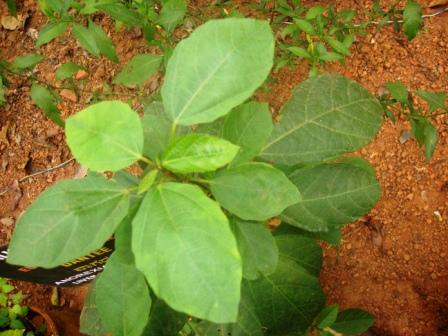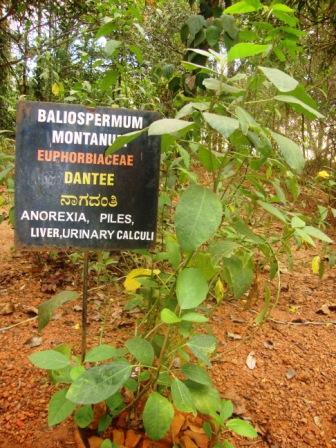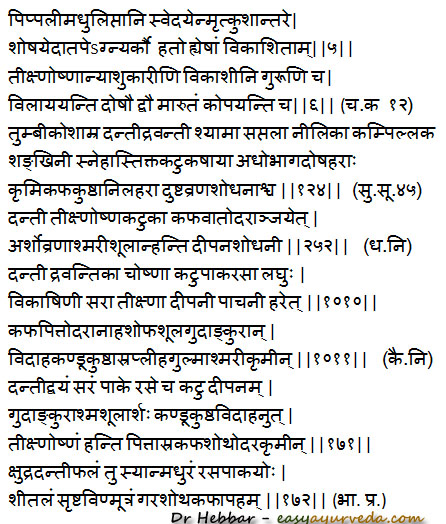Baliospermum montanum – Danti: Uses, Research, Side Effects
By – Dr JV Hebbar
Danti – Baliospermum montanum acts as purgative. It induces diarrhea and is useful in treating liver disorders, digestive disorders, hemorrhoids etc.
Botanical Name- Baliospermum montanum Muell. (Baliospermum axillare Blume; Jatropa Montana Willd.)
Family- EUPHORBIACEAE ( Eranda kula)
Table of Contents
Vernacular names
Names in different languages:
English name – red physic nut, wild castor, wild croton and wild sultan seed, i
Hindi Name- Danti
Tamil name- Niradimuthi
Telugu name- Cinna Nepalam
Tamil Name- Niradimuthi
Brngali name- Harun, Haphun
Marathi name- Danti

Sanskrit synonyms
Danti, Hastidanti – Danti – “dantidantasamam gajadantsadrusham mulamasya” – root resembles elephant tusk
Udumbaraparni – “udumbarsyevourdhwasthitani parnanyaasya” – Leaves resemble to those of Udumbara – Ficus racemosa
Erandaphala – erandasyeva phalanyasya fruit resembles castor fruit.
Erandapatrika – The lower leaves of Danti resembles Eranda
Sheeghra – spreads in the body swiftly
Upachitra – upagatani chitrani beejaanyasya
Chitra -“ chitritani beejanyasya” With mottled seeds
Ghunapriya -“ghunanam priya” roots are usually infested by fungus.
Vishalya – “vigat shalyabhutam malamanaya”
Vishodhani – “malam vishodhayati , rechanityartha” The root induces purgation, diarrhea
Madhupushpa- “madhuyutani pushpanyasya” Flowers full of nectar Shambar – “sham kalyanam vrunotiti” And is wholesome.
Nikumbha – It clenses koshta as it has purgative action
Pratyak shreni, Mukoolaka, Varahangi
Classical categorisation
Charaka-
Bhedaniya – group of herbs used in purgation,
Mulini dravyas – group of herbs having root as its mainly used part.
Sushruta- Shyamadi, Adhobhagahara – group of herbs useful in Virechana – elimination of morbid toxins from rectal route
Vagbhata- Shyamadi

Varieties, distribution
Kaiyadeva – Danti and Dravati together considering them as two varieties of Danti.
Chakrapani, while commenting on Danti explanation of Charaka, mentioned that Danti has black roots and Dravanti has red coloured roots.
Bhavamishra quotes Danti Dvaya Viz. Laghu Danti & Brihat Danti (Dravanti)
Ra. Ni – Danti and Bhadra Danti
Danti is identified as Baliospermum motanum.
Dravanti is identified as Croton tiglium or Jatropha curcas
Distribution- Distributed in tropical and subtropical Himalayas and as well as in South India
Major chemical constituents
Root- Baliospermin, Montanin
Seeds- Axillarenic acid (Reference: Illustrated Dravyaguna Vijnana, Vol. II, by Dr JLN Shastry)
Medicinal properties
Baliospermum montanum medicinal Properties
Rasa (taste) – Katu (pungent)
Guna (qualities) – Guru(heaviness), Teekshna (strong, piercing)
Vipaka- Katu – undergoes pungent taste conversion after digestion
Veerya- Ushna – hot potency.
Effect on Tridosha – Balances Kapha and Pitta.
Prabhava – Purgation
“Danti and Chitraka – Though Danti – Baliospermum montanum is identical with Chitraka (plumbago zeylanica) in respect of Rasa (taste) etc, Danti is a purgative while Chitraka is not. Hence, purgation is the Prabhava of Danti.” – Ashtanga Hrudaya Sutrathana 9
Part used, dosage
Part Used- Root, Leaves, Seed, Seed oil
Dosage-
Root powder 1-3 g
Seed powder 125-250 mg
Seed oil 2-5 drops
Purification method
Danti Shodhana : Purification method – As per Charaka, Danti root is coated with paste made with Pippali (long pepper) and Madhuka (Madhuca longifolia). This mass is wrapped in grass, tied, and wrapped in mud covering. This is heated by fire and sunlight. By this method, the toxicity of Danti is reduced.
Sanskrit verse

Uses
Danti – Baliospermum montanum uses:
Ashukari – The active ingredients of Danti spreads rapidly in the body, once taken orally
Vikashi – If taken in excess, it causes loosening of joints, intoxication
Krumihara – useful in worm infestation, infected wounds
Kushtahara – useful in skin diseases
Kaphahara – balances Kapha, useful in productive cough, asthma
Vatahara – useful in treating disorders of Vata Dosha imbalance such as neuralgia, paralysis, constipation, bloating, etc
Dushtavrana Shodhana – cleanses infected wounds
Udara – useful in ascites
Arshoghna – useful in piles, hemorrhoids
Ashmarihara – relieves urinary stones
Shoolahara – relieves abdominal colic pain
Deepana – improves digestion strength
Pachana – digestive,
Shodhana – cleansing
Sara – induces mobility, causes diarrhea, purgation, relieves constipation
Anahahara – relieves gas, fullness of abdomen, bloating
Shophahara – relieves swelling, edema, anti inflammatory
Vidahahara – Relieves burning sensation
Kanduhara – useful in relieving pruritus (excessive itching)
Kushtahara – useful in skin diseases
Asra, Pittasranut – useful in bleeding disorders
Pleehahara – useful in spleen disorders, splenomegaly
Gulmahara – useful in abdominal tumors
Krumihara – useful in worm infestation, infected wounds
Fruit qualities
Baliospermum montanum fruit –
Madhura – sweet in taste
Sheetala – coolant
Srushta Vinmurta – causes urination, purgation
Garahara – relieves chronic toxicity
Shothahara – relieves swelling, edema, anti inflammatory
Kaphahara – balances Kapha, useful in productive cough, asthma
Usage in piles
The root paste is applied externally over the pile mass. It causes reduction in pain, swelling and causes shrinking of pile mass.
External application
Dantimoola – root is made into paste and applied externally over blunt injury and arthritis region to relieve pain and swelling.
Its seed oil is applied externally to relieve Vata disorders – neurological disorders, paralysis etc.
Its seed is made into paste and applied as Kajal in snake bite treatment.
Method of administration
If taken directly, it causes twitching abdominal pain and nausea. Hence its decoction (Kashayam) is prepared, mixed with aniseed powder or Ajamoda powder and administered.
Side effects
Overdose can cause twitching pain, nausea, diarrhea.
It is not indicated during pregnancy, lactation and in children.
It should be taken strictly under medical supervision.
Toxic effects
Pain, diarrhea, Nausea, Excessive salivation, Tachycardia, Vertigo, Respiratory collapse
Remedial measures
Stomach wash, Administration of demulcent, and supportive measures
Antidote:
Milk
Tender coconut water
Interaction with medicines, supplements
Can this be used while taking Homeopathic medicine?
Yes. This product does not react with homeopathic medicine.
Can this medicine be continued while taking supplements like multivitamin tablets, Omega 3 fatty acids etc?
Yes. Generally, this product goes well with most dietary supplements. However, if you are taking more than one product per day, please consult your doctor for an opinion.
With western
medicines
Seek your
doctor’s advice if you are taking this product along with other western
(allopathic / modern) medicines. Some Ayurvedic herbs can interact with modern
medicine.
If both Ayurvedic and allopathic medicines are advised together, then it is
best to take Allopathic medicine first, wait for 30 minutes and then take the
Ayurvedic medicine.
Ayurvedic medicines
Ayurvedic medicines with Danti Ingredient:
Punarnavadi Guggulu – used in the treatment of gout, sciatica, low back ache etc.
Dantyarishtam – used in the treatment of hemorrhoids, constipation, gastric, intestine and spleen related diseases.
Bahushala Guda – It is mainly used in the treatment of piles, fistula, ascites, anemia, liver diseases etc
Shiv Gutika –It is used for a variety of diseases like liver and spleen disorders, respiratory conditions, neuro-psychiatric conditions etc.
Research
Experimental evaluation against diabetic nephropathy
In vitro micropropagation
Miscellaneous uses
Danti, along with other herbs such as Chitraka, Vacha, Dravanti, Asafoetida, Coral, Bida salt and Sochal salt are used in preparing Madhyama – Teekshna Kshara.
In case of skin diseases where the skin lesions are numb and absolutely aesthetic, if there is absence of sweating and itching, then they are rubbed with the brush made of the stem of Danti. Reference: Charaka Chikitsasthana 7/56
Morphology
Under shrub with herbaceous branches
Leaves – Toothed, Upper leaves – small, lanceolate. Lower leaves are large, ovate
Inflorescence – Axillary raceme or contracted panicle
Fruits – Capsule, usually hairy,
Seeds – Ellipsoid, smooth, mottled
Useful parts – Root – Cylindrical, hard, grayish brown in color, bearing warty protuberances at some places. On breaking becomes fibrous, has pungent odor and bitter taste
Sthanika Karma (Systemic Action)
External – Root and seed paste has Analgesic and Anti inflammatory action. Relieve pain and edema. Seed oil is beneficial in diseases due to vitiated vata dosha. External application of root paste is beneficial in Hemorrhoids.
Digestive System – Carminative, Liver stimulant, Purgative, and facilitate the release of pitta from gallbladder. indicated in Loss of appetite, constipation, hepatic disorders, hemorrhoids, Helminthiasis etc.
Circulatory System – Raktasodhaka (Indicated in generalized edema.
Respiratory System – Leaf decoction is indicated in Breathing disorders.
Excretory system – Asmari nasanam (indicated in renal calculi)
Skin – Indicated in skin disorders
Tapakrama – Indicated in Fever (vibandhayukta jvara)
Satmikarana – Collyrium with its seed paste is indicated in snakebite as per Classical Ayurvedic Texts. (It has Vikasi and Vishaghna (Anti poisonous action)
Official Substitute
चित्रकाऽभावतो दन्ती क्षारः शिखरिजोऽथवा |
Bhavaprakasha Nighantu Mishra Varga – Pratinidhi Dravya
In case of absence of Chitrak, Kshara of Danti or Kshara of Apamarga can be used.










